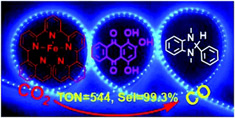Publication
886
Dalton Trans. 48 (26), 9596-9602, 2019
DOI:10.1039/C9DT00425D
|
|
|
|
|
|

|
A molecular noble metal-free system for efficient visible light-driven reduction of CO2 to CO
|
|
|
|
Lingjing Chen, Yanfei Qin, Gui Chen, Mingya Li, Lirong Cai, Yongfu Qiu, Hongbo Fan, Marc Robert, and Tai-Chu Lau
School of Environment and Civil Engineering, Dongguan University of Technology, Guangdong, China
Univ Paris Diderot, Sorbonne Paris Cité, Laboratoire d'Electrochimie Moléculaire, UMR 7591 CNRS, 15 rue Jean-Antoine de Baïf, F-75205 Paris Cedex 13, France
Department of Chemistry, City University of Hong Kong, Tat Chee Avenue, Hong Kong, China
A new pentadentate quinoline–pyridine ligand and its iron (1), cobalt (2) and nickel (3) complexes have been synthesized and characterized. The iron complex exhibits excellent photocatalytic activity towards CO2-to-CO conversion with a TON(CO) of 544 and a selectivity of 99.3% using the commercially available organic dye purpurin as the photosensitiser and BIH as the electron donor. In contrast, the cobalt and nickel complexes result in very low activity for CO production with a TON of only 8 and 15, respectively. On the other hand, all the three complexes show good electrocatalytic activity for CO2 reduction when using 2,2,2-trifluoroethanol as the proton source with the active intermediate of M0 species. The lack of activity in photocatalytic CO2 reduction by 2 and 3 can be attributed to the redox potential of MI/M0 which is significantly more negative than that of PP−/PP2− while in the case of 1 the FeI/Fe0 redox potential becomes more positive than that of the PP−/PP2− couple. |

